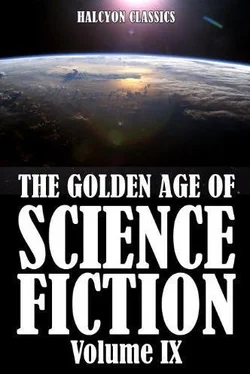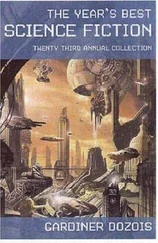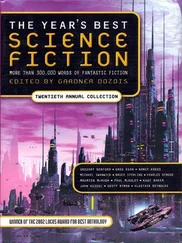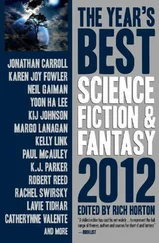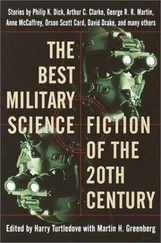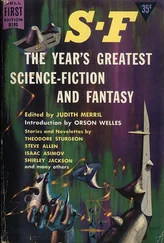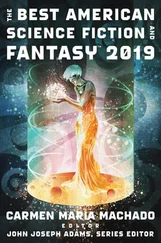Finally, a brief test-attack was made, with an entire fleet of one hundred ships. They drew almost into position, faster than light, faster than the signaling warnings could send their messages. In position, all those great ships strained and heaved at the mighty magnetic vortex that twisted at the field of the fort. Instantly, twelve of the fifteen-foot UV beams replied. And—two great UV beams of a size the Mirans had never seen before, beams from the two ships, “S Doradus” and “Cepheid.”
The test-attack dissolved as suddenly as it had come. The Mirans returned to Jupiter, and to the outer planets where they had further established themselves. Most of the Solar system was theirs. But the Solarians still held the choicest planets—and kept the Mirans from using the mild-temperatured Mars.
“They can’t take this, at least,” sighed McLaurin as they retreated from Luna.
“I didn’t think they could—right away. I’m wondering though if they haven’t something we haven’t seen yet. Besides which—give them time, give them time.”
“Well, give us time, too,” snapped McLaurin. “How are you coming?”
Buck smiled. “I’m sure I don’t know. I have a machine but I haven’t the slightest idea of whether or not it’s any good.”
“Why not?”
“I can destroy—I hope—but I can’t build up their ray. I can’t test the machine because I haven’t their ray to test it against.”
“What can we do to test it?”
“The only thing I can see is to call for volunteers—and send out a six-man cruiser. If the ship’s too small, they may not destroy it with the big crumbler rays. If it’s too large—and the machine didn’t work—we’d lose too much.”
Twelve hours later, the IP men at the Lunar Bank fort were lined up. McLaurin stepped up on the platform, and addressed the men briefly, told them what was needed. Six volunteers were selected by a process of elimination, those who were married, had dependents, officers, and others were refused. Finally, six men of the IP were chosen, neither rookies nor veterans, six average men. And one average six-man cruiser, one hundred and eleven feet long, twenty-two in diameter. It was the T-208, a sister ship of the T-247, the first ship to be destroyed.
The T-208 started out from Luna, and with full acceleration, sped out toward Phobos. Slowly she circled the satellite, while distant scouts kept her under view. Lazily, the Miran patrol on Phobos watched the T-208, indifferent to her. The T-208 dove suddenly, after five fruitless circles of the tiny world, and with her four-foot UV beam flaming, stabbed angrily at a flight of Miran scouts berthed in the very shadow of a great battle cruiser, one of the interstellar ships stationed here on Phobos.
Four of the little ships slumped in incandescence. Angrily the terrific sword of energy slashed at the frail little scouts.
Angrily the Miran interstellar ship shot herself abruptly into action against this insolent cruiser. The cruiser launched a flight of the mercury-torpedoes. Flashing, burning, ultra-violet energy flooded the great ship, harmlessly, for the men were, as usual, protected. The Miran answered with the neutron beam, atomic and gamma bombs—and the crumbler ray.
Gently, softly a halo of shimmering-violet luminescence built up about the T-208. The UV beam continued to flare, wavering slightly in its aim—then fell way off to one side. The T-208 staggered suddenly, wandered from her course—whole, but uncontrolled. For the men within the ship were dead.
Majestically the Miran swung along beside the dead ship, a great magnetic tow-cable shot out toward it, to shy off at first, then slowly to be adjusted, and take hold in the magnetic shield of the T-208. The pilots of the watching scout-ships turned away. They knew what would happen.
It did. Five—ten—twenty seconds passed. Then the “dead-man” took over the ship—and the stored power in the atostor tanks blasted in a terrible flame that shattered the metal hull to molecular fragments. The interstellar cruiser shuddered, and rolled half over at the blasting pressure. Leaking seams appeared in her plates.
The scouts raced back to Luna as the Miran settled heavily, and a trifle clumsily to Phobos. Miran radio-beams were forcing their way out toward the Miran station on Europa, to be relayed to the headquarters on Jupiter, just as Solarian radio beams were thrusting through space toward Luna. Said the Miran messages: “Their ships no longer crumble.” Said the Solarian messages: “The ships no longer crumble—but the men die.”
* * *
His deep eyes burning tensely, Buck Kendall heard the messages coming in, and rose slowly from his seat to pace the floor. “I think I know why,” he said at last. “I should have thought. For that too can be prevented.”
“Why—what in the name of the Planets?” asked McLaurin. “It didn’t kill the men in the forts—why does it kill the men in the ships, when the ships are protected?”
“The protection kills them.”
“But—but they had the protective oscillations on all the way out!” protested the Commander.
“Think how it works though. Think, man. The enemy’s field is an electric-field oscillation. We combat it by setting up a similar oscillating field in the metal of the hull ourselves. Because the metal conducts the strains, they meet, and oppose. It is not a shield—a shield is impossible, as I have said, because of energy concentration factors. If their beam carried a hundred thousand horsepower in a ten-foot square beam, in every ten square feet of our shield, we’d have to have one hundred thousand horsepower. In other words, hundreds of times as much energy would be needed in the shield, as they used in their beam. We can’t afford that. We had to let the beams oppose our oscillations in the metal, where, because the metal conducts, they meet on an equal basis. But—when two oscillations of slightly different frequency meet, what is the result?”
“In this case, a heterodyne frequency of a lower, and harmless frequency.”
“So I thought. I was partly right. It does not harm the metal. But it kills the men. It is super-sonic. The terrible, shrill sounds destroy the cells of the men’s bodies. Then, when their dead hands release the controls, the automatic switches blow up the ship.”
“God! We stop one menace—and it is like the Hydra. For every head we lop off, two spring up.”
“Ah—but they are lesser heads. Look, what is the fundamental difference between sound and light?”
“One is a vibration of matter and the—ah—eliminate the material contact!”
“Exactly! All we need to do is to let the ships operate airless, the men in space suits. Then the air cannot carry the sounds to them. And by putting special damping materials in their suits, we can stop the vibrations that would reach them through their feet and hands. Another six-man ship must go out—but this ship will come back!”
And with the order for another experimental ship, went the orders for commercial supplies of this new apparatus. Every IP ship must be equipped to resist it.
Buck Kendall sailed on the six-man scout that went out this time. Again they swooped once at Phobos, again Miran scout-ships crumbled under the attack of the vicious UV beams. The Mirans were not waiting contemptuously this time. In an instant the great interstellar ship rose from its berth, its weapons working angrily. The crumbler ray snapped out at the T-253.
Kendall stared into the periscope visor intently. Clumsily his padded hands worked at the specially adapted controls. The soft hiss of the oxygen release into his suit disturbed him slightly. The radio-phones in his helmet carried all the conversations in the ship to him with equal clarity. He watched as the great ship angled angrily up—
Читать дальше
